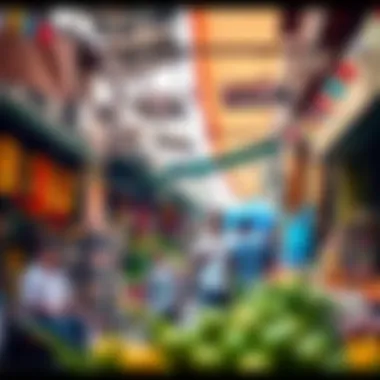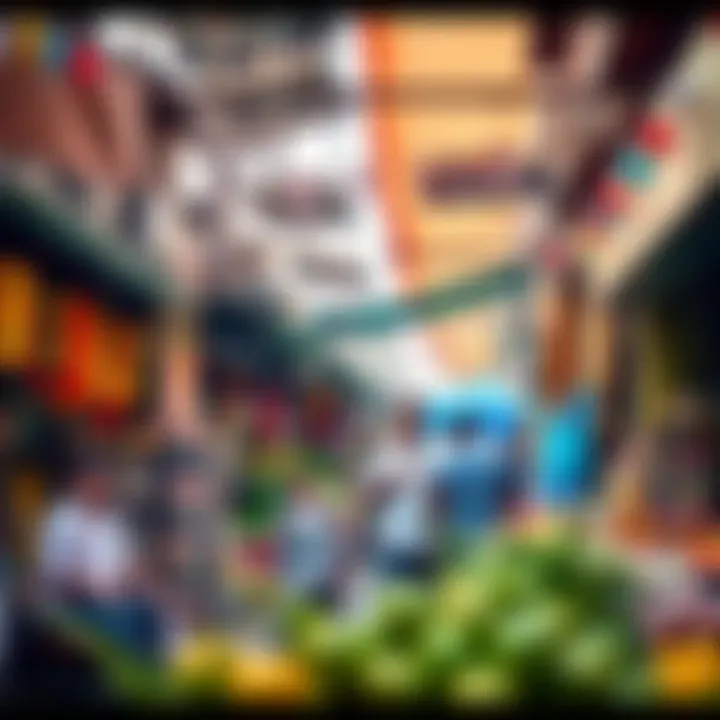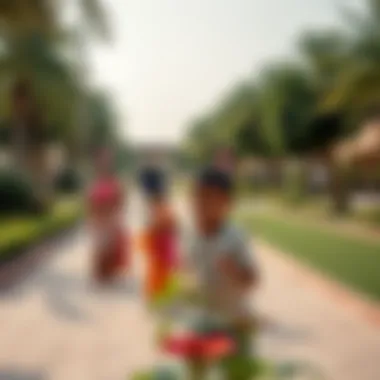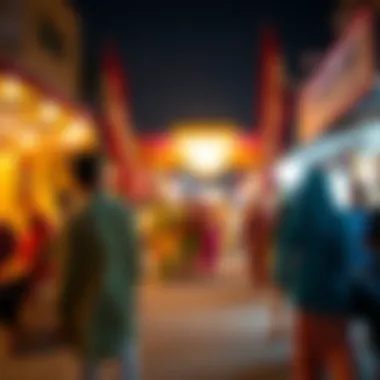Exploring Indian Neighborhoods in Dubai


Intro
Dubai has transformed into a melting pot of cultures, drawing individuals from across the globe, and within this dynamic landscape, the Indian community has carved an undeniably significant niche. Understanding the essence of Indian residential areas in Dubai is not just about geographical boundaries; it’s a journey into rich traditions, vibrant lifestyles, and economic insights that shape these livable avenues.
From bustling markets to serene parks, these neighborhoods sing a tune that resonates deeply with families and professionals alike. The allure of these Indian districts, like Karama and Bur Dubai, reveals a blend of modern amenities interspersed with age-old customs. This article digs beneath the surface, providing a roadmap through the complexities of real estate investments, cultural influences, and market dynamics that govern these flourishing sectors.
As we delve into Market Insights, we will uncover current trends in the Dubai real estate scene, alongside predictive analyses that offer a glimpse into future developments. Whether you’re a prospective homeowner, an investor seeking your next high-return property, or an expatriate searching for a community that feels like home, this exploration is tailored just for you.
Prolusion to Indian Communities in Dubai
Indian communities in Dubai play a pivotal role in shaping the city's cultural and economic landscape. When exploring this vibrant metropolis, one cannot overlook the significant influence of Indian expatriates, who have established roots in various neighborhoods, bringing along their heritage and traditions. This introduction aims to set the stage for a deeper understanding of how these communities enhance Dubai's diversity while contributing to its growth.
The importance of this section lies not just in recognizing the Indian population but also in acknowledging the rich tapestry they weave into the fabric of Dubai. With their distinct culture, social practices, and diverse professional backgrounds, Indians in Dubai have created a unique enclave that fosters both tradition and modernity.
Several factors underscore the value of understanding Indian communities in Dubai:
- Cultural Enrichment: Indian festivals, cuisine, and customs enrich the local culture, engaging a broader audience. Events like Diwali and Holi are celebrated joyously, attracting residents from all backgrounds.
- Demographic Significance: Indians form one of the largest expatriate groups in Dubai, making their demographic trends vital for businesses and policymakers aiming to serve this segment effectively.
- Economic Contribution: The Indian community significantly contributes to the economy, tocking various sectors from real estate to technology, thus impacting market dynamics.
Overall, comprehending the role and essence of Indian communities in Dubai serves as a foundation for exploring the specific neighborhoods where they reside, ultimately leading to a clearer picture of the real estate landscape and communal life.
Cultural Significance
The cultural significance of Indian communities in Dubai cannot be overstated. Culture shapes the way residents interact, celebrate, and build their lives, making it a core part of community identity. In Dubai, Indian culture adds vibrancy through art, music, and culinary experiences, creating an engaging local environment.
For example, the food scene is dominated by a plethora of Indian restaurants, from local dhabas serving quick bites to upscale dining establishments like Rang Mahal and Bombay Brasserie, capturing the essence of Indian flavors. Likewise, cultural festivals become platforms for community engagement; the annual Indian Independence Day celebration at the World Trade Center attracts vast crowds, showcasing performances and exhibitions.
Moreover, the community's cultural significance extends beyond festivities and food. The establishment of cultural centers like the Indian Consulate and various expatriate associations fosters social cohesion, providing a space for shared experiences and support.
Demographic Overview
Understanding the demographic overview of Indian communities in Dubai is crucial for grasping their influence on the city. As of 2021, estimates suggest that nearly 3.5 million Indians reside in the UAE, with a substantial portion living in Dubai. This large population exhibits a mix of professionals, artists, and entrepreneurs, contributing to a rich socio-economic environment.
The demographics can be broken down into several key characteristics:
- Age Distribution: The Indian community is diverse in age, with a significant number of young professionals attracted by Dubai's job opportunities. This dynamic youth population brings innovative ideas and entrepreneurial spirit.
- Educational Background: A considerable portion of Indian expatriates hold higher education degrees, particularly in fields such as engineering, healthcare, and finance. This educated demographic drives demand for services and products across various sectors.
- Economic Roles: Indians engage in various professions—from hospitality to real estate—thus expanding their impact across multiple industries.
These demographic insights not only showcase the size and diversity of the Indian community but also highlight their foundational role in Dubai's growth and development. Understanding these aspects paints a comprehensive picture of the vibrant Indian residential areas in the city, setting the stage for further exploration of their neighborhoods.
Key Indian Residential Areas
The Indian communities in Dubai are spread across various neighborhood that cater to diverse lifestyles, preferences, and budgets. Each area bears its unique charm and significance, with influential factors such as cultural relevance, proximity to workplaces, and available amenities driving the housing decisions of expatriates and locals alike. Understanding these crucial residential areas is essential for potential homebuyers, investors, and anyone interested in the vibrant tapestry of Indian culture richly woven into the fabric of Dubai.
Bur Dubai
Historical Context
Bur Dubai holds a significant place in the history of Dubai, showcasing a journey from a modest trading post to a bustling metropolitan hub. The roots of Bur Dubai can be traced back to the 19th century when it served as a vital passageway for traders, linking the Gulf with the interior of the Arabian Peninsula. Its heritage is embodied in the many traditional buildings and souks that sipermembers a glimpse into Dubai's past. This area remains a popular choice for residents as it provides a unique blend of history and modernity. The Al Fahidi Historical Neighborhood, for instance, features preserved monuments that engage visitors, creating a picturesque path to explore traditional Emirati culture.
Real Estate Trends
In terms of real estate, Bur Dubai is a dynamic landscape. Recently, the area has seen a surge in property development that marries modern designs with elements of cultural heritage. Many residential options range from heritage homes to modern high-rises, catering to a variety of tastes and budgets. The demand for property in Bur Dubai has prompted competitive pricing, making this area attractive for both investments and homeownership. This push for modernization is a significant factor influencing its real estate trends, enhancing its appeal as a middle-ground option for families and individuals alike.
Community Amenities
Community amenities in Bur Dubai are plentiful and varied, contributing to its popularity among residents. From bustling street markets offering an array of goods to malls like BurJuman providing a blend of local and international retail experiences, there's something for everyone. Additionally, the area boasts various health facilities, educational institutions, and parks, creating a well-rounded community environment. Residents benefit from easy access to restaurants and cultural centers that enrich their daily lives.
Karama


Local Landmarks
Karama is known for its vibraant atmosphere and is dotted with local landmarks that embody its essence. The Karama Market is a sensory experience; it attracts visitors with its colorful stalls, lively environment, and diverse food options. The area also houses several mosques and community centers that facilitate a strong sense of belonging among residents. These landmarks not only enhance the area’s lively spirit but also serve as gathering places that foster community relationships.
Residential Options
In terms of residential offerings, Karama provides a variety of choices. The area is graced with numerous apartments, from budget-friendly to slightly more upscale options, appealing to both small families and young professionals. Rent prices remain relatively moderate, making Karama an attractive option for those looking for affordable housing in Dubai, while still being close to the city’s commercial hubs. However, older buildings may not come with the modern luxuries seen in new developments, so potential renters should conduct careful evaluations.
Market Analysis
Looking at the market dynamics, Karama has shown resilience amidst fluctuations in Dubai's real estate sector. The demand for rentals tends to remain stable, largely due to the area’s accessibility and local amenities. Karama has solid grounding as a family-friendly neighborhood, translating to consistent interest from both buyers and renters. An ongoing concern, however, is the potential oversupply of housing that might impact market prices in the future, making it vital for investors to stay informed about the trends in this area.
Jumeirah
Luxury Living
Jumeirah epitomizes luxury living in Dubai. Known for its stunning villas and oceanfront properties, this area commands high-value real estate investments. Residents enjoy a lifestyle filled with high-end amenities, exclusive beach access, and a vibrant social scene. The residences boast modern designs, often accompanied by breathtaking views of the coastline, which appeals to affluent individuals seeking a lavish lifestyle.
Investment Potential
With its high demand and limited availability of properties, Jumeirah represents a compelling investment opportunity. The area remains highly sought after, both by local and international investors, translating into strong capital appreciation over the years. Furthermore, its strategic location, close to recognizable landmarks like the Burj Al Arab, ensures sustained interest in residential properties. However, the price tags attached to these luxurious homes mean that only those with significant financial resources typically benefit directly from this market segment.
Community Lifestyle
The community lifestyle in Jumeirah is vibrant and eclectic, appealing to a diverse mix of expatriates and affluent locals. The area is packed with fine dining establishments, boutique shopping, and upscale recreational facilities, creating a lifestyle that prioritizes leisure and comfort. This strong emphasis on lifestyle amenities solidifies Jumeirah’s status as a premier residential choice for those seeking luxurious living in Dubai.
Al Quoz
Art and Culture Scene
Al Quoz stands out as a cultural hub in Dubai. Known for its thriving art scene, the area is home to various art galleries, creative studios, and cultural spaces. The art district attracts local and international artists, making this area a vibrant and inspiring place to live. Events held throughout the year foster a community spirit, positioning Al Quoz as an area where creativity flows freely and residents engage actively with the arts.
Residential Developments
As the demand for artistic living spaces rises, Al Quoz has witnessed innovative residential developments aimed at creative professionals. Many buildings are designed with open layouts and modern aesthetics, appealing particularly to artists and trendsetters. While these residential developments tend to be priced at a premium, they reflect the area’s unique character and potential for artistic investment. However, it's worth noting that not all buildings are equipped with extensive amenities, so prospective residents should assess their needs.
Accessibility
Accessibility is a key consideration for anyone looking to make Al Quoz their home. The area is well-connected to major roads and public transportation options like the Dubai Metro, making daily commutes manageable for residents. Close proximity to Dubai's main business districts adds to the allure, as many young professionals can easily reach their workspaces. The ease of movement can also be seen as a double-edged sword, however; residents should be mindful of traffic patterns during peak hours which could impact travel times.
Real Estate Market Dynamics
Understanding the dynamics of the real estate market is crucial for anyone interested in the Indian residential areas of Dubai. This section delves into the unique characteristics of the market, including fluctuations in demand, price trends, and potential investment avenues. The intricate interplay of these factors shapes the attractiveness of living in or investing in these neighborhoods. For prospective buyers and investors, grasping these market elements can prove invaluable when making informed decisions.
Market Trends Analysis
In the last few years, the Indian residential markets in Dubai have witnessed a significant evolution. Notably, areas like Bur Dubai and Karama have seen a steady increase in property values due to rising demand. The current trend leans towards a preference for apartment living, especially for young professionals and families seeking affordability without compromising on quality.
Key trends include:
- Growing Expat Population: The influx of expatriates, particularly Indians, has led to increased pressure on the housing supply. This surge fuels demand for both rental and purchase options throughout the residential neighborhoods.
- Shift Towards Modern Amenities: Many buyers are looking for residences equipped with modern facilities. Properties that offer amenities such as gyms, pools, and community areas are becoming more appealing. This shift is pushing developers to invest in innovative designs and lifestyle-oriented projects.
- Sustainability Focus: More investors are becoming conscious about environmental concerns. There is a growing interest in developments that demonstrate sustainability practices, like energy-efficient designs and reduced carbon footprints.
Investment Opportunities
For investors eyeing the Indian residential sectors of Dubai, the potential is abundant. Here are key opportunities that can be harnessed:
- Emerging Neighborhoods: Areas such as Al Quoz are gradually transforming into hotspots due to ongoing redevelopment projects. Investors can capitalize on lower initial property prices before the areas become fully established, potentially leading to higher capital appreciation.
- Short-term Rentals: With an increasing number of tourists visiting Dubai, short-term rentals are in high demand. Platforms like Airbnb allow property owners to capitalize on the tourist influx, often securing higher returns than traditional long-term leases.
- Commercial and Mixed-Use Properties: As the residential communities grow, the need for commercial properties also rises. Investing in mixed-use developments can provide dual income streams, appealing to both residents and business ventures.
"The right time to invest is when you’re ready, and when the market trends are favorable, especially in a vibrant place like Dubai."


Infrastructure and Connectivity
In any city, especially one as vibrant and bustling as Dubai, infrastructure and connectivity play crucial roles in shaping residential areas. For Indian communities in Dubai, these elements are pivotal not only for daily commuting but also for fostering a sense of community and accessibility. A well-connected neighborhood is likely to attract both potential homeowners and investors, enhancing its desirability.
One might wonder why infrastructure is so vital to residential areas. Well, it’s a simple case of demand and supply. The presence of robust infrastructure means improved quality of life. Schools, hospitals, shopping centers, and parks all require a solid foundation of roads, public transport, and utility services. When these are up to par, residents find it easier to settle in, creating a stable environment.
Transportation Links
Transportation links in Indian residential areas cater to diverse mobility needs. A well-structured transport system ensures that residents can easily access their workplaces, schools, and recreational spots. For example, the Dubai Metro, known for its reliability, has several stops that serve popular residential neighborhoods like Bur Dubai and Karama.
Public transportation options are not just limited to the metro; bus routes crisscross the city, making commuting more convenient. Riding the RTA buses is a common sight, packed with school children, workers, and families. These links provide affordability and flexibility, enabling a broader segment of the population to navigate the urban landscape without the hefty price tag of a personal vehicle.
Moreover, ride-hailing services such as Uber and Careem flourish in these neighborhoods. With numerous pickup points and the emergence of electric scooters and cycle-sharing systems, residents have myriad choices to suit their traveling preferences.
"Access to reliable transport can cut commuting time and boost overall satisfaction for residents."
Proximity to Major Attractions
The allure of Indian residential areas in Dubai extends beyond just homes; their proximity to major attractions significantly enhances their appeal. Living close to landmarks like Burj Khalifa or Dubai Mall places residents at the heart of the action.
In neighborhoods like Jumeirah, families can find not only vibrant community centers but also quick access to beautiful beaches and parks. The Dubai Marina, known for its waterfront lifestyle, is just a short ride away for those residing in Al Quoz. Such convenient locations mean residents can make the most of both modern luxuries and cultural experiences in the city.
Several attractions cater specifically to the interests of the Indian community as well. For instance, Shindagha Historic District and the Dubai Museum allow residents to connect with their rich cultural heritage while exploring new facets of life in Dubai. Having these cultural touchstones nearby can foster a sense of belonging, making home feel like a real sanctuary.
Cultural Influence on Real Estate
Understanding cultural influences on real estate is paramount when one delves into the Indian residential areas in Dubai. The Indian expatriate community in Dubai is not merely a tenant group; they bring their customs, values, and traditions. These elements significantly shape the real estate landscape, from the types of housing that are popular to the amenities and services that thrive in these areas.
One notable aspect is community cohesion. Many Indian families prefer neighborhoods that allow for cultural camaraderie, fostering a sense of belonging. The celebration of festivals like Diwali and Eid often takes root within these communities, manifesting in decorations, local gatherings, and cultural fairs. Such events elevate the neighborhood's charm, making them attractive not just to current residents but also to potential buyers. Real estate developers and investors are keenly aware of this dynamic. They often plan developments with community spaces that can accommodate large gatherings and marketplaces that cater to the Indian palate.
Moreover, the presence of Indian cultural elements raises the demand for specific architectural styles and residential features. Buildings may reflect a more traditional style, often integrating design elements from Indian heritage. When you stroll through areas like Al Quoz or Karama, you might notice the vibrant color schemes, open courtyards, or even small temples spilling into the streets. This distinctiveness adds to the allure of these neighborhoods.
Ultimately, cultural factors impact the desirability of properties, influencing prices and investment patterns. As cultural festivals draw visitors, they can lead to increases in short-term rentals during busier periods, giving investors something to think about. In essence, navigating Dubai’s real estate market requires an understanding of these cultural nuances, as they profoundly influence not just where people choose to live, but also why they invest here.
"The interplay of culture and real estate is not just about bricks and mortar—it's about community and belonging, a phenomenon that defines the heart of Dubai's Indian neighborhoods."
Community Events and Festivals
The heartbeat of Indian neighborhoods in Dubai can often be found through their vibrant community events and festivals. These gatherings are more than mere celebrations; they’re a demonstration of cultural heritage and a means of reinforcing the community spirit among residents. Key festivals like Diwali, Holi, and Eid draw participation from residents and amplify local pride.
Such events create a window into the rich tapestry of Indian traditions, translating directly into community bonding. Neighbors come together to share meals, culminating in an atmosphere of joy and unity. Markets pop up, showcasing traditional clothing, sweets, and local crafts, thereby boosting local businesses. Event organizers often have to plan for large turnouts, indicating the importance of these events in residents' lives.
Furthermore, these festivals have a significant impact on the real estate market. Properties in areas known for their spectacular arrangements for community events often see their value increase during festival seasons due to heightened interest and unit demand. For instance, homes with larger living spaces are in higher demand during festive periods when family and friends gather.
Culinary Landscape
The culinary landscape of Indian communities in Dubai is an essential facet of their cultural influence on real estate. The rich and diverse cuisine draws connections to various parts of India, making neighborhoods like Bur Dubai and Karama bustling food-centric hubs. Restaurants, street food stalls, and grocery stores offer authentic flavors and ingredients that resonate with Indian traditions.
More than just food, these establishments foster social interactions. Residents and newcomers alike discover a variety of dishes ranging from North to South India, seamlessly blending regional flavors. Delicious biryanis, spicy chaats, and sweet treats like gulab jamun become the talk of the town during festive seasons.
Investors take note: neighborhoods with a thriving culinary scene not only attract food enthusiasts but also potential homeowners. Well-known food spots often encourage residents to relocate, raising property values in the vicinity. The buzz around food also leads to new ventures, further stimulating the local economy.
In summary, community events, festivals, and culinary diversity explicitly contribute to the demographics and financial dynamics within Indian residential areas in Dubai, enhancing the real estate narrative. Investors benefiting from this understanding can make informed decisions, potentially leading to prosperous outcomes.
Challenges in the Real Estate Sector
The real estate landscape in Dubai, particularly for Indian communities, is rich with opportunity but also fraught with challenges that can make or break an investment. Understanding these challenges is crucial for potential homeowners, investors, and realtors alike. It’s not just about finding a place to live; it’s about navigating a complex web of regulations and market dynamics that can be daunting for even the most seasoned investors. The Indian neighborhoods in Dubai have their own unique hurdles, from restrictive regulatory frameworks to burgeoning market saturation, which can impact investment returns and community vitality.


Regulatory Environment
Navigating the regulatory environment in Dubai can feel like trying to find a needle in a haystack. While the government has worked to simplify processes for foreign investors and residents, there are still substantial regulations that can affect property purchases and rentals in Indian residential areas.
For instance, understanding the difference between freehold and leasehold properties is essential. In many instances, Indian investors can only buy in certain designated areas, which limits options. Compliance with local laws concerning property ownership, taxation, and lease agreements is another layer that requires careful attention.
Moreover, the recent changes in laws, such as those related to Golden Visas and residency permits, have implications for property ownership. Homeowners must stay abreast of such updates to ensure they are making informed decisions.
Potential investors should also be wary of going through unverified agents, as this can lead to misunderstandings or legal troubles down the line. In short, buying property in Dubai means being in the know about the rules of the game.
Market Saturation Concerns
Market saturation in the real estate sector is like a double-edged sword. While it may indicate that a neighborhood is hot and desirable, it can also mean that investment returns may be dwindling due to too many similar offerings.
In areas like Bur Dubai and Karama, the increased number of residential units has made it challenging to maintain rental yields. Investors looking to capitalize on these communities may find that competition is stiff, and rental prices might not be as attractive as they once were.
Additionally, the influx of new developments can sometimes outpace demand. For example, Al Quoz is seeing a surge in residential projects, but are there enough buyers or renters? It’s a gamble, and one that needs careful scrutiny.
To mitigate saturation risk, investors should consider exploring under-represented areas or upcoming neighborhoods where growth potential remains. Looking at aspects like infrastructure improvements or proximity to commercial hubs can offer insights into areas that might still have room to grow. Keeping a finger on the pulse of the market trends will enable investors to make strategic decisions that are wise and informed.
"In a saturated market, the right information can be the key differentiator for success."
In an ever-evolving landscape, awareness and adaptability are crucial. Investors, homeowners, and realtors should approach the market with a well-rounded understanding of its challenges. By doing so, they can position themselves for success in the vibrant communities populated by the Indian diaspora in Dubai, navigating hurdles with a knowledgeable hand.
Future Outlook
Understanding the future outlook of Indian residential areas in Dubai is crucial for stakeholders involved in the real estate market. This section sheds light on emerging trends, investment potential, and how cultural shifts might influence the landscape moving forward. The real estate environment in Dubai, particularly within Indian communities, is undergoing significant transformations influenced by economic trends, regulatory changes, and demographic shifts. Hence, having a grasp of future possibilities equips investors, homeowners, and real estate professionals with better judgment in their decision-making.
Predicted Trends
As we peer into the future, several trends are set to shape Indian residential areas in Dubai:
- Increased Demand for Sustainable Living: With a global push towards sustainable lifestyles, Indian expats are likely to favor eco-friendly developments that promote green living. Projects emphasizing energy efficiency and minimal environmental footprints may consistently attract attention.
- Rise in Smart Homes: Technological advancements pave the way for smart homes that cater to the modern family's needs. Integrated systems controlling lighting, security, and climate could become more common, adding to the appeal of new residences.
- Shift Toward Affordable Housing: Amidst the rising cost of living, there is a growing demand for affordable housing solutions. As more families seek value for their money, developers will need to find a balance between luxury and affordability in their projects.
- Cultural Spaces and Community Constructs: As neighborhoods continue to evolve, the rise of cultural hubs showcasing Indian art, culinary concepts, and entertainment will play a crucial role in enhancing community life. Incorporating cultural spaces within residential projects can attract potential buyers.
Investment Forecasts
Investment forecasts present a mixed but optimistic view for those looking to dive into the Indian residential markets in Dubai.
- Stable Growth Potential: Analysis suggests that property prices in neighborhoods like Bur Dubai and Karama are expected to stabilize with some incremental growth. This trend makes for favorable conditions for long-term investments, as moderate price fluctuations present opportunities for buyers who are willing to hold.
- Government Initiatives: The government has committed substantial resources to infrastructure improvements and regulatory reforms. By strengthening transportation networks and enabling greater foreign ownership, the investment landscape appears promising.
The future of Indian residential areas in Dubai seems bright, as the integration of culture, technology, and sustainability drives market growth.
- Emerging Areas: As current hotspots become saturated, investors may find fertile grounds in developing districts like Al Quoz. The push for affordable housing will likely lead to better market conditions.
Ending
In wrapping up this discussion about Indian residential areas in Dubai, it's vital to reflect on the many layers that contribute to the allure and complexity of these neighborhoods. Understanding the fabric of these communities provides a broader perspective on Dubai's real estate landscape. Not only does it reveal market dynamics, but it also highlights cultural significance, demographic trends, and the unique character each neighborhood brings to the city.
Importance of Community
The Indian community forms a crucial part of Dubai's expatriate population. This group's diverse backgrounds and rich traditions shape the local culture, from cuisine to community events. Residents often find comfort in familiarity, which is evident in the vibrant markets, traditional restaurants, and cultural celebrations unique to neighborhoods like Bur Dubai and Karama. It is not just about buying property; it’s about investing in a lifestyle that resonates with cultural affiliation.
Market Significance
From an investment perspective, these areas continue to attract attention. Real estate prices fluctuate based on varied factors such as location popularity, development regulations, and future forecasts discussed earlier in the article. Identifying trends in neighborhoods like Al Quoz or Jumeirah can lead to advantageous investment opportunities. Investors who understand the intricacies of these markets are better positioned to maximize their return on investment.
Future Prospects
The evolving infrastructure and connectivity in Dubai will continue to transform residential choices. Understanding these trends aids potential buyers and investors in making informed decisions. With ongoing developments and projects, staying updated on real estate forecasts presents an opportunity to navigate this dynamic environment effectively.
Overall, delving into the Indian residential areas in Dubai reveals a vibrant interplay of culture, community, and investment perspectives. This knowledge not only serves homebuyers and investors looking to settle down or profit but also enriches the general understanding of a community that significantly impacts the socio-economic tapestry of Dubai.
"In real estate, timing and understanding are everything. But community makes a space feel like home."
As the landscape evolves, so should our understanding of these neighborhoods—integrating cultural context with market insight will empower both individuals and families seeking to call Dubai home.







